Classic - apple pie
- rosemary
- Sep 10, 2023
- 7 min read
"Good apple pies are a considerable part of our domestic happiness."
Jane Austen

The first thing to say is that this is a first recipe post - and I shall come to that shortly, but I could not resist opening with this scan of a Robert Carrier Cookery Card in my possession. It is, as you can see from all the wrinkles in the card, much used. Indeed it is so delicious and such a family tradition that I cannot see me ever making any other version of apple pie, although I shall, of course give you alternatives in the following post. As you can see he calls it Old English apple pie, and you can find the recipe on the New England Apples website. I think the genius thing about this particular recipe is the fact that he rubs the inside of the pastry with a sugary spicy, mix and then layers the apples, raisins and sultanas with the mix and zested orange and lemon peel, finishing with butter and orange juice, before putting on the lid and baking. Moreover the apples are raw, not previously cooked. He obviously loved this dish which first appeared in Great Dishes of the World, was reproduced here and there in his cookbooks, and even made an appearance in his Great New Dishes of the World which was published in 1997 in his Great Classics section. I promise you this is the very, very best apple pie you will ever make. Alas I do not make it very often. It's rather too large for just two people.

So back to my first recipe book Cordon Bleu Desserts and Puddings - a small Penguin paperback chewed at the edges in my case by silverfish, with crumbling paper. The picture was found on Amazon Australia which has one second-hand copy going for - wait for it - $133! Plus postage I guess. As I have said before don't just throw out your old cookery books. Check the net first.
This edition was published in 1977, so I probably bought it when I was at the height of my Executive Wife career and needed inspiration for desserts - posh ones. I don't think I ever tried the chocolate profiteroles though. Like all those early paperbacks there are no glossy photographs. How the dishes will look when finished is up to your imagination. There is not even a heap of guidance on how to make them look good.
There are, however, occasional line drawings, some of them of actual dishes, by M.J. Mott. who, it turns out is the lady below - Miranda Jane Marie Mott a Suffolk illustrator and artist. And beside her is the illustration that fronts the first chapter in the book - Desserts made with pastry. She's so very much of her time is she not with that pearl necklace and the wavy hair? A long forgotten personage I suspect, which is sad, because the drawings are really rather lovely and evocative. There is life in this one in the almost swaying plant on the windowsill and the curtain blowing in the wind.
As this is a Cordon Bleu book by Rosemary Hume and Muriel Downes, its aim is to teach. Their main occupation after all was to run a prestigious cooking school. There is no introduction to the book as the whole, and no introduction to the first section either. We get straight into it with To make pastry, beginning with some general commandments about making pastry:
Work in a cool airy room ...
Use fine fresh sifted plain flour, firm but not hard fat and ice-cold water for mixing
Handle the flour lightly but firmly ...
Make sure the right amount of water is added ...
A piece of marble or slate shelf is ideal for rolling pastry ...
I can almost hear my cooking teacher at school as she instructed us in the fine art of making pastry by hand. No food processors or electric stand mixers here. In fact the main thing I remember from that lesson is that when crumbling the butter into the flour you had to just use your fingers and lift it high into the air - there should be no sign of flour on the palms of your hands at the end of the process. I wonder what we made with our pastry? It could well have been apple pie.
The book goes on to tell you how to line a flan ring, how to bake blind and how to line tartlet moulds before proceeding with the technically first recipe - Shortcrust pastry. However, I decided to ignore this and go to Apple pie which had more promise. Whilst I could have written a post about shortcrust pastry - and maybe I will some day - apple pie was a bit more interesting I thought.
We all know the expression "as American as apple pie" and I'm sure we all know that apple pie is not American. Well everyone except the Americans it seems. There were countless American websites explaining patiently to Americans that apple pie was actually English. Perhaps the website Southern Living summed it up best:
"Apple pie isn't nearly as American as most people believe. In fact, apples aren't even native to North America and didn't grow here until the arrival of European settlers. And cinnamon and nutmeg? Those came from as far away as Sri Lanka and Indonesia
Apple pie is American because it illustrates how cultures worldwide can join together to create something new and altogether wonderful. Like apples, we're all transplants."
'Something new'? I don't think so. But otherwise she/he is spot on. Besides pie in America actually mostly seems to mean tart. A pie has a lid. Apple tart is a completely different thing.

So where does it come from? Well, and this I did not know, it comes from this man - Geoffrey Chaucer. The man who wrote The Canterbury Tales. But he also wrote, in 1381 a cookbook called A Cook's Tales and in it was this recipe for Apple pie. Well he calls it a tart, but tells us to 'do yt in a cofyn' and coffins have lids don't they? Not just apples though - he also had figs, raisins and pears in the mix together with spices and saffron.
As Felicity Cloake says, in her piece on the perfect apple pie:
"Having looked at a few medieval recipes, many of which involve sugar, sweet spices, and butter, I’d go so far as to suggest that the typical British pie hasn’t moved on much either, and with good reason. " Felicity Cloake
This Chaucer recipe is a good example of what a wonderful thing the World Wide Web can be sometimes, for not only can you find out the facts about Chaucer's recipe, and associated pictures, along with the actual text, but you can also find an American called Chef Bill making Chaucer's apple pie in a YouTube video. Below are the finished results, plus Felicity Cloake's perfect version to compare.
Figs are an interesting addition, as is the saffron.
Of course, Chaucer's recipe was not the first time that apple pie was made. It was just the first time a recipe for it was written down. Well an English kind of apple pie. Other Europeans make apple pies of course - strudel is a kind of pie, as is a galette, or a croustade - and where there were apples I'm sure that eventually they ended up in some kind of pie, although you would have to have waited until there were ovens of some kind before attempting the feat. Maybe I should have tackled shortcrust pastry first because without the pastry you can't have the pie. There are lots of things you can do with apples that don't involve pastry. To all intents and purposes though, the origins of apple pie are lost in the mists of time.
Felicity Cloake, in her recipe, referenced Jane Grigson, but I could not find a recipe in the three books of hers that I own, which I thought might have one - her Fruit Book, Good Things and English Food. I was surprised, but not quite as surprised to see that Elizabeth David had no recipe. In fact I am amazed at who does not have a recipe - well not that my brief research in my own library and on the net as well has shown. Nothing from Nigella, or Hugh Fearnley-Whittingstall. And the Australians are no better, neither Maggie Beer nor Stephanie Alexander in their massive cookbook tomes have a recipe for apple pie. And not Belinda Jefferey either - an Australian cook who seems to have a particular interest in the sweet part of a meal. This is not to say that they do not have recipes - just that I could not find them.
The apple pies that I grew up with were simple affairs - just apples with a flavouring of sugar and cloves, and shallow pies, made in one of those pie dishes that looked like a plate with a slightly raised edge. What happened to them? I have been looking for one on and off for ages now. I don't think that my mother cooked her apples before putting them in the pie, but she would have used Bramley apples, which do tend to disintegrate into a fluffy mush when cooked. Which can actually be rather nice, but maybe slightly firmer ones are best for a pie. Delia has a similar version. And even though some, including Jamie don't always put pastry on the bottom of the pie I think you should.
So who has a good apple pie recipe? Well these are what I found, including one with blackberries from Nigel Slater - Apple and blackberry pie; and with dates from Jamie Oliver - Apple and date pie. Jamie also has a fairly plain but classic version in his Jamie's Dinners book, but I cannot find the recipe online - the picture is included below. Or you can watch him make one without pastry on the bottom, but with some interesting added flavours - he calls it Ultimate apple pie - well he would wouldn't he? Delia has two versions - English apple pie and Traditional apple pie with a cheddar crust and Heston Blumenthal's Everdure has individual Caramelised apple pies with vanilla coffee custard which I suppose are more like turnovers than a pie. And I have to say, that for me, anyway, Robert Carrier still wins hands down - An original American who became English, which is the creation story in reverse really.

One last example from Jamie however, which I couldn't resist - a savoury version, made with cheese and potatoes. Picnic food.
Cheese is often suggested as an accompaniment to apple pie - Robert Carrier suggests it somewhere, and Delia included cheese in her pastry, but Jamie has it as a major ingredient in this one. Now I could give this one a go sometime.
And to close, let's go into a much more philosophical realm with Carl Sagan, that just goes to show that food can take you anywhere:
"If you wish to make an apple pie from scratch, you must first invent the universe."








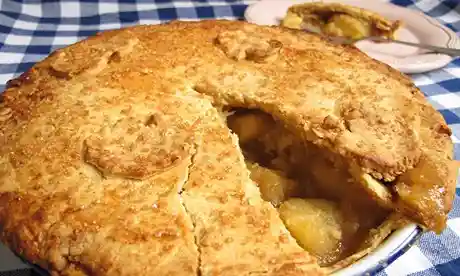
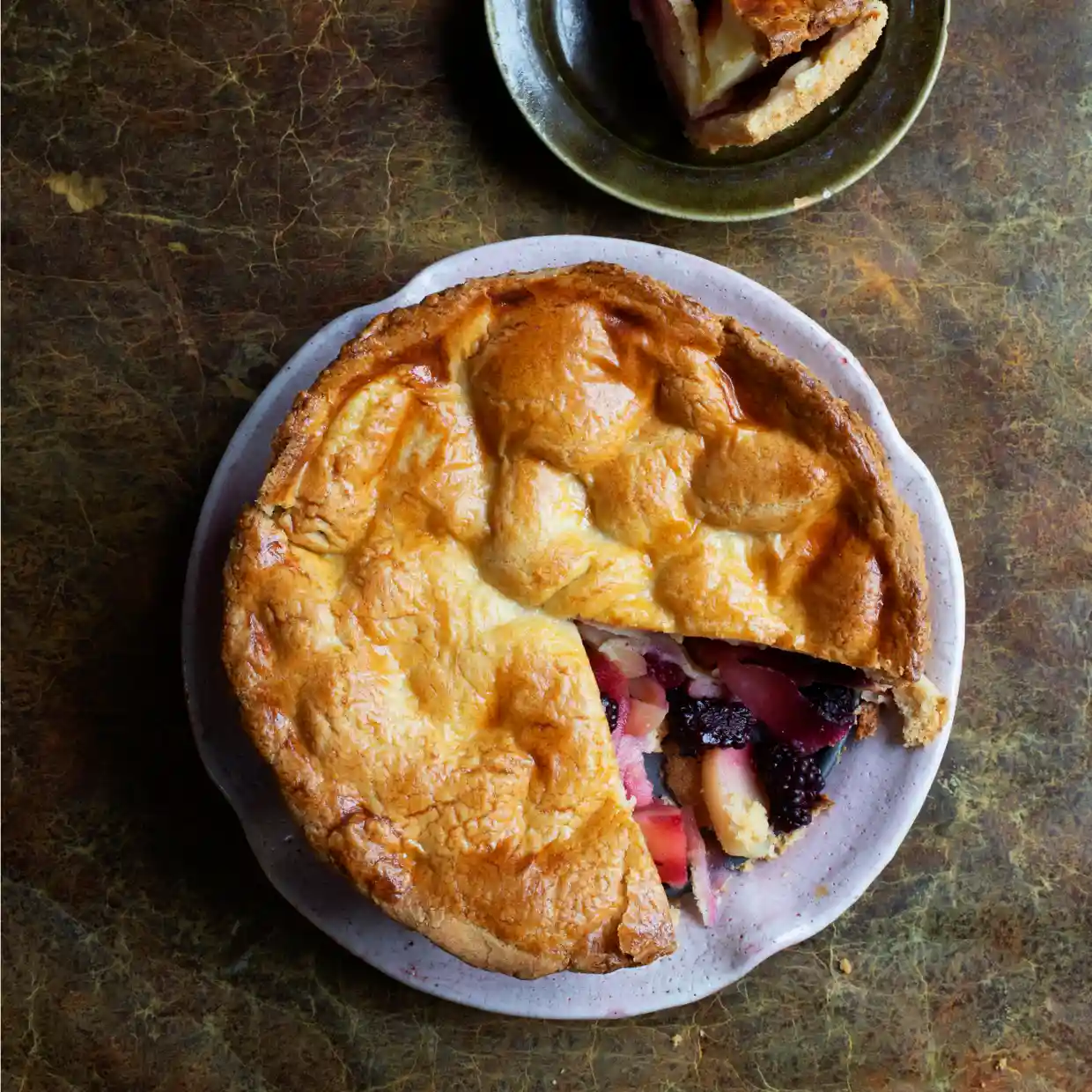
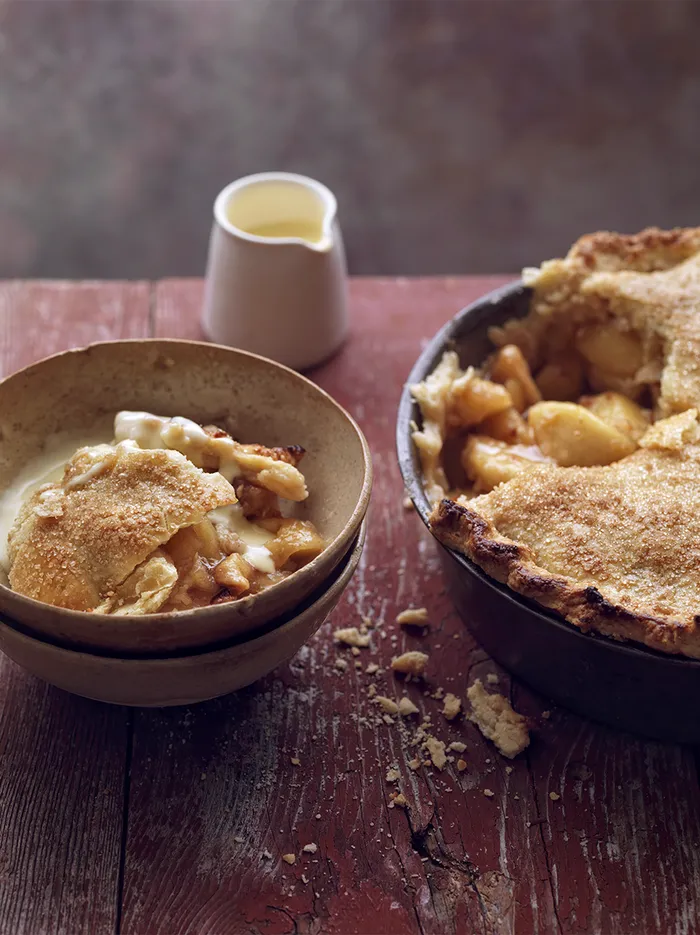


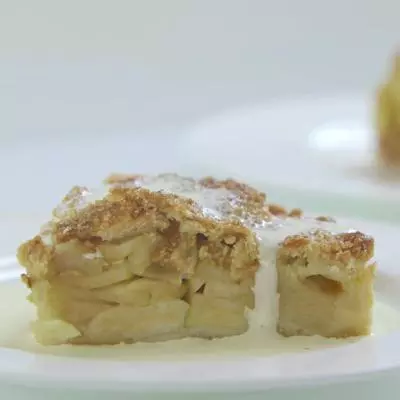
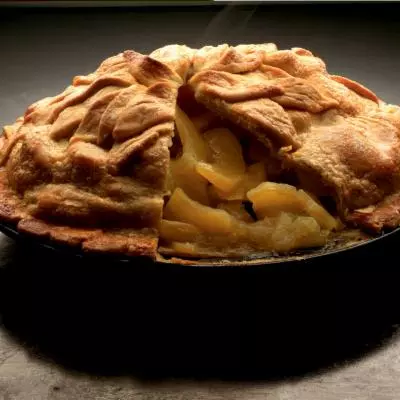





Comments